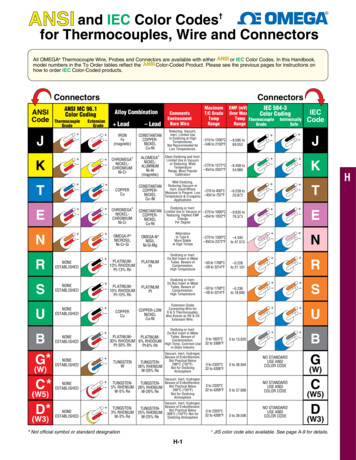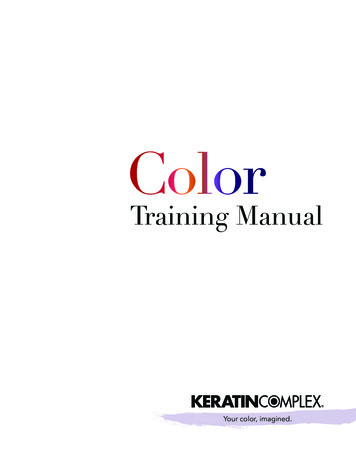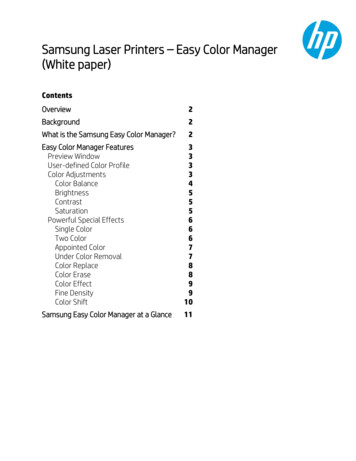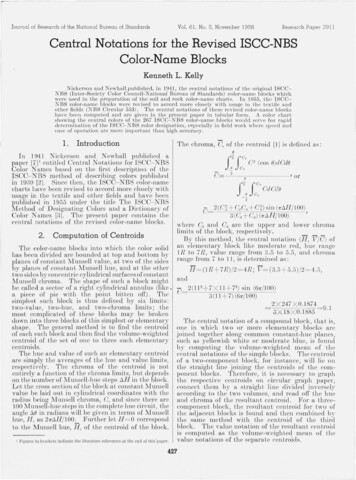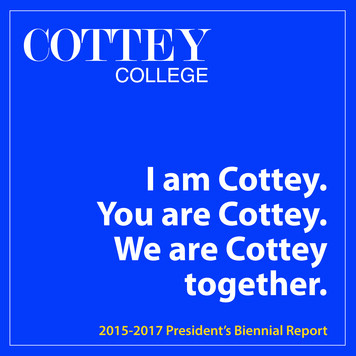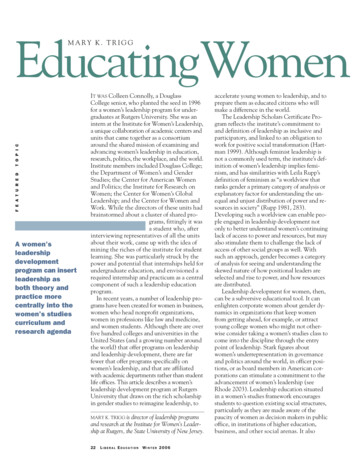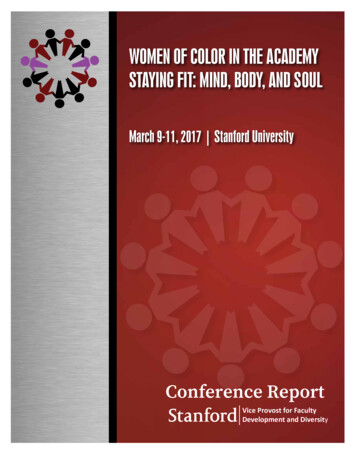
Transcription
WOMEN OF COLOR IN THE ACADEMYSTAYING FIT: MIND, BODY, AND SOULMarch 9-11, 2017 Stanford UniversityConference ReportVice Provost for FacultyDevelopment and Diversity
Copyright 2018 Leland Stanford Junior University, Stanford, California 94305.No part of this publication may be reproduced without permission. Requests for permissionshould be submitted by writing to facultydevelopment@stanford.edu.While Stanford University has used its best effort in preparing this report, the Universitymakes no representations or warranties with respect to the accuracy or completeness of itscontents and specifically disclaims any implied verification of individual credentials oraffiliations.
Women of Color in the AcademyStaying Fit: Mind, Body, and SoulMarch 9-11, 2017Conference ReportPrepared by conference co-chairs:Carol B. Muller, Ph.D.Executive Director, WISE Ventures, Stanford UniversityRania Sanford, Ed.D.Assistant Vice Provost and Director of ProgramsFaculty Development and Diversity Stanford UniversityStacy Blake-Beard, Ph.D.Deloitte Ellen Gabriel Professor of Women and Leadership, and Senior Faculty AffiliateCenter for Gender in Organizations, Simmons School of ManagementJanuary 2018
Why Create a Conference Focused on Women of Color in the Academy?The underrepresentation of women from minority groups in faculty positions in the U.S has been a longstandingchallenge for most universities.1 Numerous studies provide ample evidence of disadvantage in status andopportunities for women of color as a result of their gender and membership of a racial/ethnic minority group. Manysuggest that this disadvantage leads to a “double bind”2 or “double jeopardy,”3 with increased hurdles for survival andsuccess in the academic profession. The hurdles are manifested in reports of isolation and loneliness, feelings ofchronic distinctiveness and hypervisibility, being the object of stereotyping, experiencing stereotype threat (leading tofear of proving true the stereotypes about one’s group), and frequent attributional ambiguity (not knowing whetherfeedback received is the result of racism and/or sexism).4 Others have identified the problem of racism-based traumaaffecting women of color in academic settings, negatively impacting the physical and psychological health ofacademic women of color.5These significant challenges notwithstanding, there is evidence that women of color are innovative agents innavigating, persisting, and success.6 Among the strategies individuals employ are choosing to work and learn in safe,welcoming places; participating in diversity conferences; building alternative academic and professional networks;engaging with communities and in activities beyond disciplinary and professional realms; and, actively working tochange the status quo toward greater inclusion.7 Despite significant challenges and troubling biases in their worklives, many faculty members of color have fruitful careers, appreciating the same elements that attract and keep theirWhite counterparts in academic work: intellectual challenge and accomplishments, freedom to pursue their owninterests, and supportive academic leadership, mentors, and colleagues, where they are found.8Women of color report better well-being and success when attention is given (or dedicated) by their institutions andcolleagues to their physical and psychological health in ways that recognize and address individual experiences andneeds.9 Such attention could manifest more widely in institutional awareness and systemic change.10 Institutions suchas Stanford stand to benefit from building their knowledge of the nature of the experiences of underrepresentedwomen. Doing so facilitates deeper institutional learning, and enables more effective design of interventions tocounter the negative effects of the experiences of women of color. Such learning and design could inform appropriateand relevant systemic change in practice and culture, strengthen relationships inside and outside the institution withscholars, and intentionally provide a welcoming space to support the careers of diverse women faculty.The mission of the Stanford Office of the Vice Provost for Faculty Development and Diversity includes enabling thesuccess of underrepresented faculty and cultivating a pipeline to recruit future faculty of color to the University.Towards fulfilling this mission, we obtained funding from Stanford University’s provost to organize the conference“Women of Color in the Academy – Staying Fit: Mind, Body, and Soul,” which brought together those who areearly in their academic careers and featured a variety of high-caliber, interactive sessions designed to develop skills,strategies, and knowledge for building successful academic careers as well as opportunities for informal networking.During the summer of 2016, we talked with two groups of faculty women at Stanford about their own experiencesand what they see to be the unmet needs and potential opportunities for their colleagues to succeed. These initialconsultations led us to invite a number of mid-career and senior Stanford women faculty to be advisors to theconference. With their input, the conference co-chairs developed activities thematically along 3 axes: mind, body,and soul.y Muhs, G., Niemann, Y., Gonzalez, C., & Harris, A. (Eds). Presumed incompetent: The intersections of race and class forwomen in academia (2012). Boulder, CO: The University Press of Colorado.2Malcolm, S., The double bind: The price of being a minority woman in science, Office of Opportunities in Science, AAAS Report No.76-R3, April 1976.; Malcolm, L., & Malcolm, S. (2011, Summer). Symposium: Unraveling the double bind: Women of color in STEM.Harvard Educational Review.3Williams, Joan C. "Double jeopardy? An empirical study with implications for the debates over implicit bias andintersectionality." Harv. JL & Gender 37 (2014): 185-569.4American Psychological Association CEMRRAT2 Task Force and Committee on Women in Psychology (2017). Surviving and thrivingin academia: A guide for members of marginalized groups, pp 6-7. Downloaded from uide-members-marginalized-groups/ April 11, 20175Davis, Molly Everett, Vakalahi, Halaevalu F. Ofahengaue, & Scales, Renay, "Women of Color in the Academy: From Trauma toTransformation," Ch. 15 in De Welde, Kristine & Stepnack, Andi, Eds., Disrupting the Culture of Silence: Confronting GenderInequality and Making Change in Higher Education (2015). Sterling, Virginia: Stylus Publishing, pp. 265-2776Ong, Maria, Ko, Lily T., and Hodari, Apriel K., "Agency of Women of Color in STEM: Individual and Institutional Strategies forPersistence and Success," in Pathways, Potholes, and the Persistence of Women in Science: Reconsidering the Pipeline (2016). London.Lexington Books. pp. 183-195.7Ibid.8Turner, C. S. V, & Myers, S. L. Faculty of Color in Academe: Bittersweet Success (2000) Boston: Allyn and Bacon.9Gutierrez y Muhs, G., Niemann, Y., Gonzalez, C., & Harris, A. (Eds). op.cit.10Davis et al, op.cit., p. 2711Gutierrez1
Institutions of higher learning in general, and the work of the faculty in particular, is a labor of the mind. Throughthese 3 themes, however, we aimed also to bring attention to the importance of well-being of the body and soulalong the life journey of the intellect.Our purpose was to equip participants with knowledge, providing them with a highly interactive experientiallearning opportunity. The conference objectives were to:· promote practices for the success of academic women of color;· provide research-based findings and practical skills to advance individual capacity to appreciate challenges andopportunities that face academic women of color;· cultivate participant self-awareness and skill-building within a supportive and safe space for dialogue anddiscussion;· expand participant and Stanford faculty networks, and learn from colleagues – peers, near-peers, advisors fromStanford and other institutions; and· support opportunities to develop and implement action plans for academic career success.Who is a “woman of color”?The term “of color” in the U.S.colloquially refers to ethnic and racialclassifications that are “non-White.”There is no precise definition of thisterm, and other terms may be preferred.Individuals may identify as being “ofcolor” regardless of their ethnic andracial background.When the perceptions held by anindividual towards someone else’s“color,” cultural backgrounds, and sharedexperiences are implicated in differentialtreatment, the identification as “ofcolor” is often attenuated and becomesrelevant to the lived experiences of theindividuals involved.Further, with expanding understandingof gender as a cultural construct andnorm, the term “woman” needsincreasingly to be self-defined. And forsome, the term “of color” is problematicbecause it can be seen as grouping,treating women from different ethnicgroups as one monolithic entity.For the purposes of this conference,applicants and participants used theirown definitions of women of color. Wedid not ask for demographic categoricalidentification.We hoped the conference could enhance participants’ resilience andextend their networks, leverage scholarly and professional developmentresources at Stanford, offer an opportunity for Stanford faculty and leadersto learn about and from the participants, and engage in conversations thatwould inform institutional aspirations to recruit a diverse professoriate.National ContextIn 2013, women represented 41% of the full-time professorial faculty(professors, associate professors, or assistant professors) in U.S. degreegranting postsecondary institutions. Of this group of 207,083 women,8,407 (4%) self-identified as Hispanic or Latina (of various racial ormultiracial backgrounds), 1,527 ( 1% of women) as multiracial, 906( 1%) as American Indian/Alaska Native, fewer than 400 ( 1%) asPacific Islanders, 7% as Black, 9% as Asian/Asian American, and 75% asWhite.11 Altogether, women of color represented 8% of the full-timeprofessorial faculty.At Stanford University, of 618 female professors, associate professors,and assistant professors across the university in fall 2016 (representing28% of the total professorial faculty), 28 (4.5% of women) selfidentified as Hispanic or Latina (of various racial or multiracialbackgrounds), 14 (2.3%) as multiracial, fewer than 5 ( 1%) as AmericanIndian/Alaska Native, 110 (18%) as Asian/Asian American, 23 (3.7%) asBlack/African American, and 418 (68%) self-identified as Whiteonly.12OutreachInvitations to participate were sent to various email lists, including theNational Science Foundation Alliances for Graduate Education andthe Professoriate (AGEP), the Association for Women in Science, ADVANCE grant awardees andprogram directors, the Women in Engineering ProActive Network, and others. In addition, paid advertisementswere placed in Diverse Issues in Higher Education (website and daily newsletter) for a two-week period inlate December and early January 2017. A page on Stanford’s website (facultydevelopment.stanford.edu/conference)was developed and updated regularly with information about the conference. Additional circulation of theannouncement was made through the personal networks of co-chairs and faculty advisors. Online applicationswere due January 15, 2017.11Digest of Education Statistics, 2014, Table 315.20. Full-time faculty in degree-granting postsecondary institutions, by race/ethnicity,sex, and academic rank: Fall 2009, fall 2011, and fall 2013. Retrieved /dt14 315.20.asp April 11, 2017.12Faculty Demographics 2016, downloaded 8/5/17 from ts/faculty-demographics.2
Applicants and ParticipantsBy the deadline for applications, 965 individuals completed online applications for the 50 slots available forparticipation, half of which were intended for Stanford participants. Applicants and participants represented a widerange of definitions of diversity across gender identity, immigrant status, socioeconomic status, parental status, race,ethnicity, culture, religion, national origin, and career paths, among others. The profiles of applicants and theirresponses to the applicant question about their backgrounds illustrated the salience of intersectionality in theirexperiences as aspiring women in the academy.Through our process, we selected advanced doctoral students (completed coursework, working toward completionof dissertation), postdoctoral scholars, and early career faculty members, both on the tenure and non-tenure tracks.Our criteria for selecting participants were: Desire to pursue an academic career; Diversity among participants based on self-described identity, career stage, discipline, geographic location,current institutional affiliation; Anticipated value of the workshop for the participant; and Anticipated benefit for others as a result of the applicant’s participationThe large number of participants and the wealth of their backgrounds made the selection process a considerable taskthat was necessarily imperfect and we turned away many excellent scholars. Constrained by available resources, wemade plans, as a result, to develop online resources for those whom we regretfully declined.Fifty participants attended the full 2.5-day conference: 22 early career faculty members, 19 advanced doctoralstudents, and 9 postdoctoral scholars. The participants hailed from astrophysics, chemistry (biochemistry andanalytical chemistry), environmental engineering, forestry and conservation, geology, bioengineering, civilengineering, materials engineering, computer science, clinical psychology, biology, classics, education, ethnicstudies, American studies, Latin American studies, history, law, linguistics, political science, sociology, psychology,and feminist studies. Thirteen participants came from Stanford while 37 came from public and private institutions,liberal arts as well as research-intensive and teaching-intensive institutions from across the United States.Conference ProgramThe conference took place March 9-11, 2017 on the“I valued the space provided to engage with other women ofStanford campus. Nineteen sessions featured 20color around issues common to our experience in academia.”faculty presenters, women and men, from Stanford,– Conference ParticipantUniversity of California-Santa Barbara, University ofCalifornia-Berkeley, San Francisco State University,and the Simmons School of Management. Presenters offered information about U.S. higher education, types ofinstitutions, patterns of academic careers, mobilizing one’s own independence and interdependence for professionalsuccess in the independent cultures of institutions of higher education, juggling family and various work decisions, thenature of academic work, and aspirations past the early stages of one's career. The detailed program is included inAppendix II.Several sessions explored concepts of identity,intersectionality, and interdependence. Others providedhands-on experience to empower one’s voice andnarrative, and to give tools for negotiation skills andnavigating the challenges of the academic tenure track.The sessions enabled the participants to get to know one another and to find complementarity – both similarities anddifferences in their own journeys and also in their perspectives, disciplines and academic experiences. Participantsheard a variety of perspectives from, and networked with, slightly more advanced academic peers focusing on strategiesand tactics specific to science, engineering, and mathematics fields, or humanities and social science fields. They werealso engaged in interactive discussions focused on bias, one-on-one career coaching, taking care of one’s physical andmental wellness, exercise, and meditation. Participants gained skills and cultivated attitudes of resilience and self-careamid challenges and adversity. Where possible, meetings were arranged with Stanford faculty members, includingdepartment chairs, in their disciplinary fields."The sessions and discussion validated my experiences,as well as demystified the tenure process."- Conference Participant3
What We LearnedAs described earlier, our objectives for the conference included promoting practices for the success of academicwomen of color, providing research-based findings and practical skills to advance individuals’ capacity to appreciatechallenges and opportunities that face academic women of color. We sought to cultivate self-awareness and skillbuilding within a supportive and safe space for dialogue and discussion. We hoped to enable participants to expandnetworks and learn from colleagues – peers, near-peers, advisors from Stanford and other institutions. Conferencesessions supported opportunities to develop and implement action plans for academic career success. As organizers,we also wanted to learn what we can do in our roles to develop institutional practices that enhance and supportacademic women of color.It was clear from the outpouring of interestfrom applicants, as well as from the responseof the participants, that the conferencebrought considerable benefit to theprofessional development of the participants.“Being in community with people who have rich and unique challengesand face similar obstacles as women of color allowed a sense of safetythat enabled our gifts to shine. We were able to put down the burden ofbeing 'onlys' or one of few-- for a few days. This helped us to see andthink about ourselves more fully, to celebrate our individual andcollective contributions and to think positively and deeply about ourfuture accomplishments.”– Conference ParticipantThey highly valued having a community ofsupport and palpably experienced validation and camaraderie; many of them had had no encounters previously withother women with experiences similar to theirs.Our choice for the colloquial and broad term “women of color,” despite its limitations, avoided the constraints ofcategorical definitions, allowing individual participants to describe the reasons for their interest in and affinity withour conference theme. Conference participants engaged with each other and shared many of their experiences andambitions. Through our observation, listening to their stories and informal conversations throughout the longweekend, we could see that the participants learned from one another, directly and indirectly, where they hadcommonalities, where they differed, and the uniqueness of what each brings to her persona as an academic woman ofcolor. The value of this learning community experience was instrumental (or vital) to them and to us as observers.The complexity of intersectional identity highlights the depth and breadth of persona that characterize academicwomen of color. Intersectionality takes into account the interplay among disciplinary focus, educational experience,life experience, race, ethnicity, place/location, religion, nationality, and socioeconomic status, immigrant status,parental and paternal characteristics, just to name a few. The influence of these dimensions was evident in the natureof each participant’s engagement throughout the event as well as via their expectations.Through our welcoming session, and first dinner session, we were reminded of the dynamics of difference withindiverse groups, and the importance of skillful facilitation to attend to emotional needs, the attributional ambiguitiesthat are not only experienced, but also projected onto representations of power, whether individual or institutional.We experienced firsthand the ways in which our participants needed and expected a safe space in gatherings such asthe one we organized. We appreciated the importance of cultivating a forum where new perspectives could beexpressed and respected, and acknowledged the power of stereotypes in shaping interpersonal and intergroupinteractions. We saw the power of intersectionality at play throughout the events of the conference. We also observedthe value of cross-disciplinary engagement in enabling individuals to put their own experiences in perspective,realizing that there is not one uniform experience for "women of color" and that intersectional identities in theacademy are shaped and experienced not only as a result of one's gender identity and race/ethnicity generally, but alsoby the cultures and mores of different disciplinary fields and departments.In the closing session, participants' feedback again reinforced the finding that experiences of isolation by individualacademic women of color are extensive, real, emotionally taxing, and professionally risky. Many reported havingworked hard to earn the credentials to join the professoriate, but their talents and contributions were oftenundervalued, and their challenges unacknowledged, if not entirely unrecognized, by their colleagues, mentors andinstitutions. We learned that clear, intentional, and inclusive outreach to individuals and communities of color isnecessary for engagement.Engagement with Stanford faculty and leaders provided an opportunity to get to know potential faculty candidates.Stanford faculty members also appreciated the opportunity to meet, and “be reminded of” several stellar candidates.Last, but not least, we ended the conference with a renewed appreciation of the diversity, complexity, andperspectives that shape the choices academic women of color make every day. We came to recognize thatinstitutional and programmatic efforts that aim to address the challenge of underrepresentation must follow a variety4
of approaches designed to work within specific disciplinary cultures, and which also consider the power ofindividual experiences, and intersectional identities, and aligned with appropriate institutional resources.EvaluationAt the conclusion of the conference, we asked participants tocomplete an anonymous online evaluation of the programcontent, the participants' self-assessment of the impact of theconference, and overall satisfaction with its logistics. We“I liked that we didn't only talk about thereceived responses from 41 of the 50 participants. Nearly allproblems, but the solutions as well."respondents agreed with the following statements: 1) feeling– Conference Participantbetter prepared for an academic career; 2) feeling moreinformed about the factors that can impact “my” success in anacademic career; 3) having a better sense of what “I” need todo in order to do well as a faculty member; and 4) having some ideas to take back to colleagues and institution tosupport faculty diversity. In terms of individual conference sessions, all were rated by nearly all respondents asextremely useful or very useful.“The conference was a life-saving experiencein the sense that it gives me some concreteadvice on how to move forward in my career.”- Conference ParticipantRecommendations for Future ConferencesIn light of the responses we received, we find that the conference offered considerable benefit, and we recommend itsreplication at Stanford and elsewhere. We received critical feedback from participants about ways to enhance theirexperience of and learning from this conference. Suggestions included adding more practical tips on navigatingacademic work and environments, providing more time for interaction among faculty and conference participants,and delving more intently into the intersectional identities that participants brought to the table. We should alsoconsider being more explicit about expectations, and announce session presenters well ahead of the applicationdeadline.We extend our thanks to the former Stanford Provost, John Etchemendy, for his financial support for the conference,including providing the funding to enable participants’ attendance. We also offer our deep appreciation to ourStanford faculty advisors, faculty and non-faculty speakers, and staff who engaged in implementing the conference.These colleagues offered considerable time, expertise and creative energy which added immeasurably to theconference.5
APPENDICESI. Program FlyerII. Conference Program Agenda and ParticipantsIII.Selected Participant Evaluation Open-EndedResponses - Organized by Category6
I. Conference Flyers7
WOMEN OF COLOR IN THE ACADEM STAYINGFIT:MINO,BODY,ANOSOUL Apply Now!2.5-day Professional Development andNetworking Conference for AdvancedGraduate Students, Postdoctoral Scholars,and Early Career FacultyMarch 9-11, 2017Stanford University, Stanford, CAShare Experiences. Get Inspired. Gain Insights.Participants will learn of research-based findings and practical skills toadvance their individual capacities towards navigating the challengesand opportunities as academic women of color; to expand professionalnetworks, and to learn both the art and science for a range of academicstrategies and processes, including negotiating job offers, academicauthenticity, and approaching tenure, from peers and more seniorcolleagues at Stanford and elsewhere.Participants will have an opportunity to develop action plans for successin the next step of their academic careers.Organized by Diversity&lnclusion@Stanford and Stanford WISE VenturesDeadline to Apply: January 15, 2017 11 :59 PM PST and for moreinformation, go to o-ChairsCarol B. Muller, PhDExecutive DirectorWISE Ventures, StanfordRania Sanford, EdDAssistant Vice ProvostFaculty Developmentand Diversity, StanfordStacy Blake-Beard, PhDDeloitte Gabriel Professor ofWomen and Leadership, andSenior Faculty Affiliate,Center of Gender inOrganizations, SimmonsSchool of ManagementFaculty AdvisorsAllyson HobbsAssociate Professor,History, StanfordFei-Fei LiAssociate Professor,Computer Science,StanfordPaula MoyaProfessor,English, and by courtesy,Iberian & Latin AmericanCultures, StanfordJennifer RaymondProfessor, Neurobiology,StanfordSponsored byVice Provost for FacultyStail1Qfc. d I Development and Diversity8
Vice Provost for FacultyS tafi1Qfc. d I Development and DiversityWomen of Color in the AcademyStaying Fit: Mind, Body, and SoulMarch 9-11, 2017Stanford University, Stanford, CAShare Experiences. Get Inspired. Gain Insights.In 2.5-days, participants will learn of research-based findings andpractical skills to advance individual and institutional capacitiestowards navigating the challenges and opportunities as academicwomen of color; to expand professional networks, and t o learn both theart and science for a range of academic strategies and processes,including negotiating job offers, academic authenticity, and approachingtenure, from peers and more senior colleagues at Stanford andelsewhere.Conference Objectives Promote practices for the success of academic women of color, Provide research-based findings and practical skills to advanceindividual capacity to appreciate challenges and opportunities thatface academic women of color, Cultivate self-awareness and skill-building within a supportive andsafe spaces for dialogue and discussion, Expand networks, and learn from colleagues- peers, near-peers,advisors from Stanford and other institutions, and Support opportunities to develop and implement action plans foracademic career success.Faculty AdvisorsAllyson HobbsAssociate Professor,History, StanfordFei-Fei LiAssociate Professor,Computer Science,StanfordPaula Moya Professor,English, and by courtesy,Iberian & Latin AmericanCultures, StanfordJennifer RaymondProfessor, Neurobiology,StanfordConference Co-ChairsCarol B. Muller, PhD, Executive DirectorWISE Ventures, StanfordRania Sanford, EdD, Assistant Vice Provost Faculty Developmentand Diversity, StanfordStacy Blake-Beard, PhD, Deloitte Gabriel Professor of Women andLeadership, and Senior Faculty Affiliate, Center of Gender inOrganizations, Simmons School of ManagementConference CoordinatorLaurita Wheeler, StanfordOrganized by Diversity&lnclusion@Stanford and Stanford WISE Ventures9WOMEN OF COLOR IN THE ACADEMY STAYING FIT: MIND, BODY, AND SOUL
II. Conference Program Agenda and Participants10
All Sessions in Tresidder Oak West2:30 p.m. – 3:00 p.m.Shuttle pick-upCardinal Hotel (2:30 p.m.), Westin Hotel (2:45 p.m.)3:00 p.m. – 4:00 p.m.Registration4:00 p.m. – 4:15 p.m.Welcome4:15 p.m. – 5:00 p.m.IntroductionsCarol Muller, Executive Director, WISE Ventures, Stanford UniversityRania Sanford, Assistant Vice Provost and Director ofPrograms, Faculty Development and Diversity, Stanford UniversityStacy Blake-Beard, Deloitte Ellen Gabriel Professor ofWomen and Leadership, and Senior Faculty Affiliate, Center for Genderin Organizations, Simmons School of ManagementCarol Muller, Executive Director, WISE Ventures, Stanford UniversityLori Mackenzie, Executive Director, Clayman Institute for GenderResearch, Stanford University5:00 p.m. – 5:15 p.m.Break5:15 p.m. – 6:30 p.m.To Thrive in the Academy, ROAR!6:30 p.m. – 6:45 p.m.Short Break/Walk to Faculty Club6:45 p.m. – 8:00 p.m.Dinner (Gold Lounge, Faculty Club)7:20 p.m. – 7:45 p.m.In Pursuit of HappinessKaran L. Watson, Provost and Executive Vice President;Regents Professor, Departments of Electrical Engineering, andComputer Science, Texas A&M UniversityFred Luskin, Director, Stanford University ForgivenessProject, Senior Consultant in health promotion at StanfordUniversity, and Professor at the Institute for TranspersonalPsychology.8:00 p.m. – 8:15 p.m.Closing8:15 p.m.Shuttle pick-up311WOMEN OF COLOR IN THE ACADEMY STAYING FIT: MIND, BODY, AND SOUL
All Sessions in the Gold Lounge, Faculty Club7:30 a.m. – 8:00 a.m.Shuttle pick-up8:00 a.m. – 8:30 a.m.Morning Activity8:30 a.m. – 9:00 a.m.Breakfast and Overview of the Day9:00 a.m. – 10:00 a.m.U.S. Higher Education: Mapping the LandscapeCardinal Hotel (7:30 a.m.), Westin Hotel (7:45 a.m.)Meditation with Tia Rich, Director, Contemplation by DesignOr Brisk campus walk with Carol Muller and Stacy Blake-BeardChris Golde, Assistant Director of Career Communities - PhDs &Postdocs , BEAM – S
“Women of Color in the Academy – Staying Fit: Mind, Body, and Soul,” which brought together those who are early in their academic careers and featured a variety of high-caliber, interactive sessions designed to develop skills, strategies, and knowledge for building successful academic
